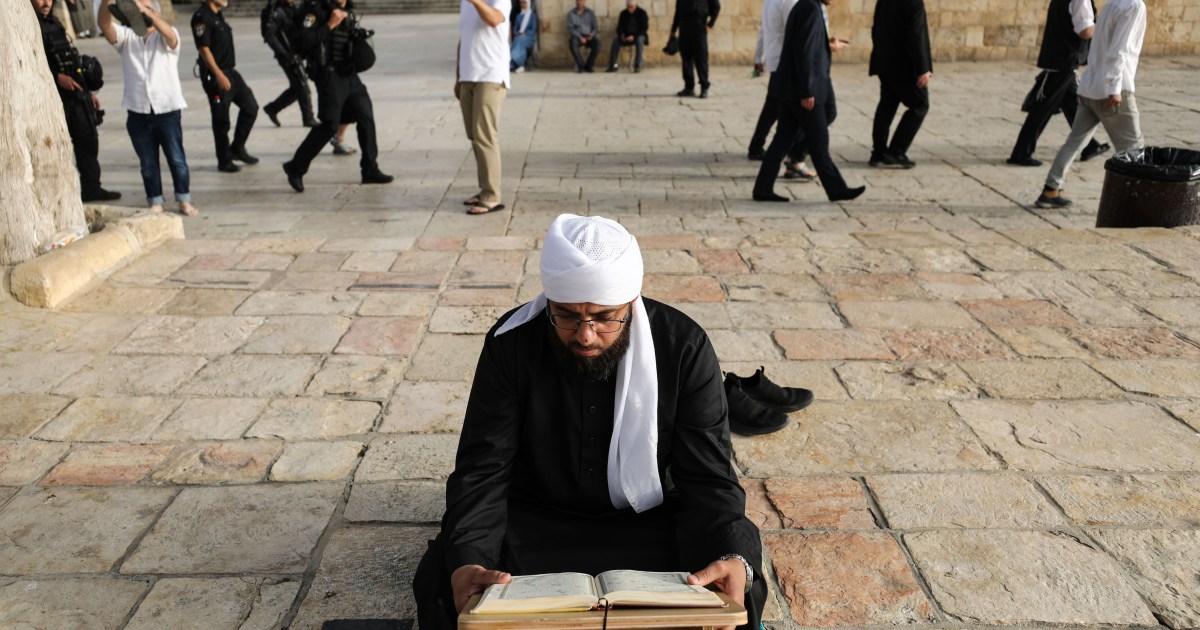Occupied Jerusalem -
The sound of a recorded speech by Abu Obeida, spokesman for the Izz al-Din al-Qassam Brigades, then sirens sounded inside the courtyards of Al-Aqsa Mosque. Astonishment mixed with joy overwhelmed the worshipers, and that was only one of the chapters of "acoustic confusion" in Al-Aqsa Mosque.
"And masked over the tribal Salah al-Din with his heart, for the mosque will not leave, I know my path, the Dome of the Rock is in the soul like arterial blood, touching the rock is not allowed, touch it and see my heart." Al-Aqsa Mosque, as part of a series of national anthems glorifying Jerusalem and Al-Aqsa.
Percussion and magnifications
These chants, speeches, and recorded sirens, which began this morning, coincided with a continuous knocking on the interior doors of the Al-Qibli prayer hall that started since last Sunday, April 17, and which was intensifying coinciding with the passage of the intruders in front of the Al-Qibli prayer hall between the Kass and the southern Al-Baikah.
Those who made these confusing sounds are a group of Palestinian youths who kept seclusion inside the Qibli prayer hall, and closed its doors to prevent its intrusion by the occupation forces that were waiting for them throughout the incursion and for 3 and a half hours a day from seven until ten thirty in the morning.
sound weapon
After the intensive occupation targeted the worshipers and the detainers through arrest, deportation and direct bodily injury, before and during the Hebrew Passover, whose first day intersected with the current 14th of Ramadan, the detainers today used the method of audio confusion, after the matter began by broadcasting motivational speeches and calls for distress through Al-Aqsa Mosque headphones last Sunday .
The speeches disturbed the occupation by cutting off the electricity to the speakers and minarets of Al-Aqsa Mosque, but the worshipers were able to restore it and continue broadcasting the speeches, so the occupation tried to penetrate the Qibli prayer hall from the side of the Women’s Mosque adjacent to the west, to reach the audio room and the call to prayer in the Qibli prayer hall, thinking that the speeches were transmitted through it.
The sound confusion took another turn, after the firecrackers were fired from inside the al-Qibli prayer hall, to make sounds similar to shooting, creating an atmosphere of terror and confusion among the forces and settlers.
Al-Quds activist Muhammad Abu Al-Hummus describes this to Al-Jazeera Net, "I was at Al-Aqsa and I saw the fear in their faces. They were very surprised, despite the simple capabilities of the young men, but it made a difference."
Cross-yard confusion
The acoustic confusion was not limited to the interior of the gray domed tribal prayer hall, but also to the courtyards of Al-Aqsa Mosque opposite the prayer hall, to the courtyard of the Dome of the Rock, where some worshipers sat on the ground or terraces and read the Qur’an aloud, and said the takbeer repeatedly as soon as the groups of intruders passed by.
The voices of young men in al-Qibli in the south, and the elderly on the terraces in the middle, converged with the voices of women to the north near the rock, who raised their voices by saying the takbeer, reciting the Qur’an and anthem, and with the occupation forces besieging them, pushing and beating them, but the chant of “God is our master and they are not in charge, we are not their temple.” It was louder and reverberated throughout the mosque.
Throwing horror
“Our voice frightened them, despite their equipment and their number. I saw tension and fear in the faces of the settlers and the armed forces that are heavily guarding them,” said the Jerusalemite Fatima Bakri, who documented, via a live broadcast, the settlers’ incursions and the vocal confusion in his confrontation.
"The settlers were angry and tried to provoke the worshipers and insulted them and raised the victory sign, but that did not hide their fear," she added.
And for the third day in a row, settlers stormed Al-Aqsa Mosque in the morning, coinciding with the Hebrew Passover, as the number of stormers since Sunday reached 1,674 settlers, according to the Islamic Endowments Department, while their usual incursions did not stop since the beginning of Ramadan, but were limited only to the morning period, after it was evening ( afternoon) also before the holy month.
recurring danger
Despite the decline in the number of those in the Al-Aqsa Mosque due to preventing the people of the West Bank from accessing, obstructing entry through the mosque’s doors, and campaigns of administrative detention and deportation, day and night I’tikaf are still in place in the mosque to repel intrusions, prevent any attempt to slaughter the Easter sacrifice there, or carry out rituals other approach.
Other methods
In addition to the sound confusion, the worshipers scattered glass and stones to the east of Al-Aqsa Mosque, close to the wall, and erected stone and wooden barricades, to prevent settlers from passing through the place or standing in it, after they used to storm it before Ramadan, pray there and give religious sermons.
While participating in cleaning the courtyards of Al-Aqsa and the entrance to the tribal prayer hall after the end of the storming period, the sixty-year-old Khair Al-Shimi from the Palestinian interior told us, “Yes, they stormed our mosque, but they entered it frightened. or easy.

